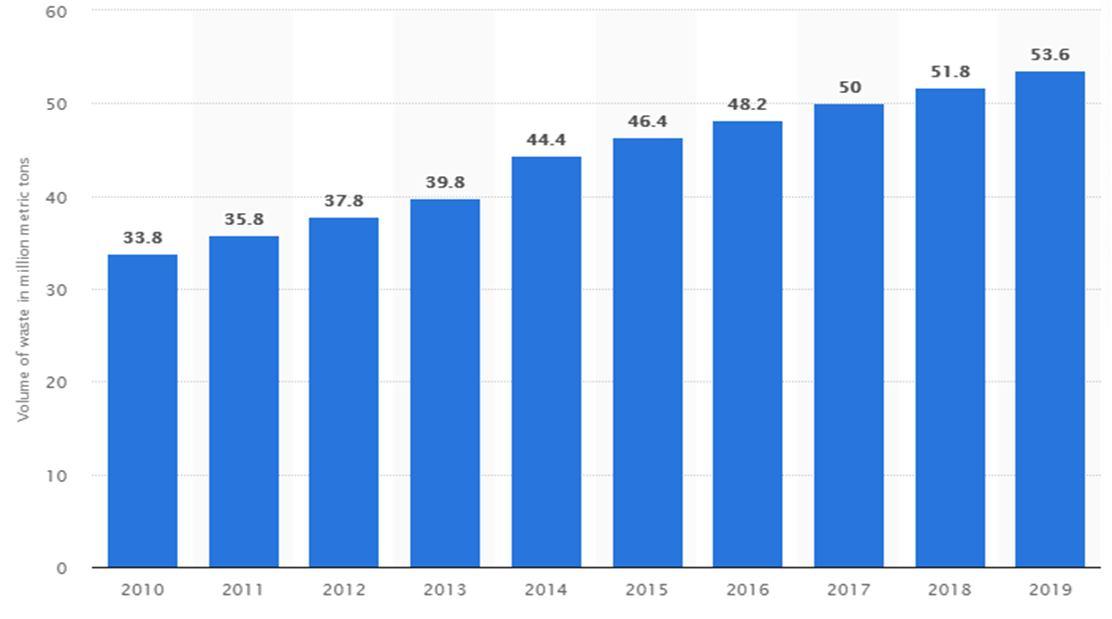
13 minute read
Review on Solvents for Extraction of Metals from Waste Electrical and Electronic Equipment (WEEE)
from Review on Solvents for Extraction of Metals from Waste Electrical and Electronic Equipment (WEEE)
by IJRASET
Aghogho Blessing Obukohwo Division of Environmental Sciences, Department of Life Science, Brunel University London
Abstract: Waste Electrical and Electronic Equipment (WEEE) are electrical and electronic gadgets known to have reached their end-of-life. They are made of printed circuit boards (PCBs) containing valuable metals like copper, gold, iron, lead nickel, silver, tin and zinc which can leach into the environment when landfilled. Current extraction methods for the recovery and recycling of metals from WEEE uses various solvents which are not selective, releases toxic gases and recover metals in a mixed form which requires further purification steps to recover individual metals. This paper has reviewed the use of inorganic acids, organic acids and designer solvents which do not release toxic gases when used for extraction of metals from WEEE. The results reveal that ionic liquids ae promising solvents for extracting metals.
Advertisement
Keywords: e-waste, WEEE, metals, leaching, ionic liquids, inorganic acids, solvents
I. INTRODUCTION
When wastes have the potential to be recycled and converted to useful materials they are considered as secondary raw materials with great value. Rich ores for the refining of metals are getting scarce gradually and other materials such as low-grade ores and other secondary sources such as tailings, solid and liquid wastes are now considered as economical sources of metal by metallurgical industries. Urban mining is a term widely used to describe the recovery of metals from anthropogenic wastes. In other words, it is a process of recovering elements or compounds from wastes. Some examples of such wastes are Waste Electrical and Electronic Equipment (WEEE), electroplating wastes and tannery waste. The metals present in these mixed waste streams include both hazardous, transition and precious group metals (mercury, lead, lithium, antimony, beryllium, cadmium, copper, silver, platinum, gold, nickel, zinc). When WEEE and other metal bearing wastes are sent to landfills they may contaminate groundwater due to leaching of metals; they may also pollute soil and air due to fire outbreak or release of hazardous components; they can also fill up landfill volume (Sum, 1991; Spalvins, 2008; Adediran & Abdulkarim, 2012; Damodaran et al., 2013; He and Xu, 2014; Kumar et al., 2014; Letsrecycle, 2020; Zhang & Xu, 2016). Wastes containing valuable or hazardous metals may need to be sorted for reuse or recycling. In WEEE, the mixture of metals and other materials is heterogenous and this has led to a serious challenge in selective recovery of desired materials. The recovery is low as metals are lost in slag and gaseous effluents is high. However, researchers have also combined complexants and oxidants to study the dissolution of metals. It has been reported by Kumar et al., 2014 that 100 % of zinc and copper were dissolved when a combination of 2 mol/L H2SO4 and 0.2 mol/L H2O2 were used to leach printed circuit board (PCB) at 85 0C for 8 hours. According to Dhawan et al., 2009, HNO3 is more effective than HCl and H2SO4 in leaching metals from PCB and these mineral acids are known to be really aggressive for metal recovery they are disadvantaged as they release toxic gases (NOx, Cl2 & SO2). Metal recovery through this process is non-selective as the metals are extracted in a mix and a further purification step is required (Sum, 1991; Oh et al, 2003; Veit et al., 2005; Dalrymple, 2007; Oishi et al 2007; Eswaraiah et al., 2008; Wu et al., 2008; Dhawan et al., 2009; He and Xu, 2014; Kumar et al., 2014; Jadhav & Hocheng, 2015; Wang et al. 2016; Zhang & Xu, 2016). Various types of organic acids are considered as environmentally friendly leaching agents and have been used for the extraction of Pb and PbO from scrap battery paste by Sonmez & Kumar, 2009. Citric acid and acetic acid were used to leach large PCB but poor metal slubilization was observed as only 9.89 % and 19.57 % of copper respectively was recovered. However, 100 % Li and 90 % Co have been recovered using 1.25 M citric acid and 1 % vol H2O2 at 90 0C for 30 min and a solid to liquid ratio of 20 g/L. The combination of IL extractants have yielded more results than organic solvents in metal ion extraction (Seal et al., 2003; Chen et al., 2004; Chen & Tsai, 2004; Du et al., 2004; Pandija et al. 2007; Sonmez & Kumar, 2009; Li et al., 2010; Jadhav & Hocheng, 2015; Wang et al. 2016).
ISSN: 2321-9653; IC Value: 45.98; SJ Impact Factor: 7.538

Volume 11 Issue I Jan 2023- Available at www.ijraset.com
II. WASTE ELECTRICAL AND ELECTRONIC EQUIPMENT (WEEE)
Waste Electrical and Electronic Equipment (WEEE) is defined as equipment that require the use of electricity for its function and they are also regarded as equipment which works with electrical networks. Examples are cell phones, computers, televisions, batteries, refrigerators which have reached their end-of-life. These gadgets are made up of wires, printed circuit boards (PCBs), cathode ray tubes (CRT) and liquid crystal display (LCD). Some of the valuable materials WEEE is made up of are metals, plastics, glass and other materials (Figure 2.1 and Table 2.1). These materials contain precious group metals like gold and silver, heavy metals like iron, copper, nickel, lead, cobalt, chromium, cadmium along with other hazardous materials like brominated flame retardant (BFR). Table 2.2 shows some useful and hazardous components present in WEEE. Every year, between 34 - 54 million metric tons of Waste Electrical and electronic equipment (WEEE) are generated globally and this figure is growing yearly (Habashi, 1999; EU, 2003; Huang, 2009; Terada, 2012; Ogunseitan, 2013; He and Xu, 2014; Zhang & Xu, 2016; Statista, 2021). The research by Kiddee et al., 2013 showed that 500 million tons of computers were discarded in the United States while at the end of 2010 about 610 million tons of computers became outdated in Japan (Kiddee et al., 2013; Park et al., 2014; Hadi et al., 2015; Zhang & Xu, 2016). In Nigeria for instance, 60,000
71,000 tons of used equipment are imported yearly and the largest market for computers in Ikeja, Lagos and the Computer and Allied Product Dealers Association stated that about 75 % of the electronics shipped to the country are considered wastes from the source country; 19 % of these electronics do not function properly and are already near their end-of-life but they become useful to the Nigerian second-hand market as the level of poverty does not allow the people to afford new gadgets hence the reason for the large market of e-waste. The solid waste heap is a source for mixed metals (Adediran & Abdulkarim, 2012; Letsrecycle, 2020).
WEEE
Main components
Cell phone LCDs, PCBs, wires, battery
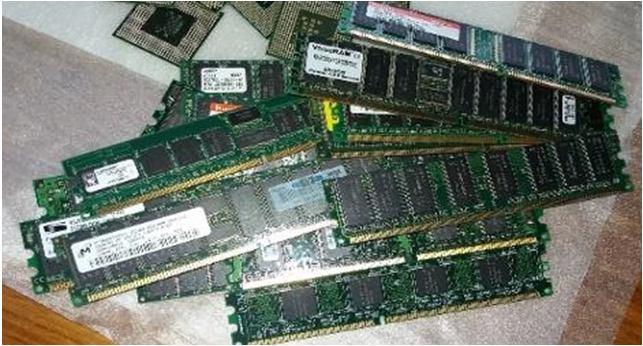
Computer LCDs, PCBs, wires, CRTs, speakers, battery
Television LCDs, PCBs, wires, CRTs, speakers, demagnetized coil, deflection yoke
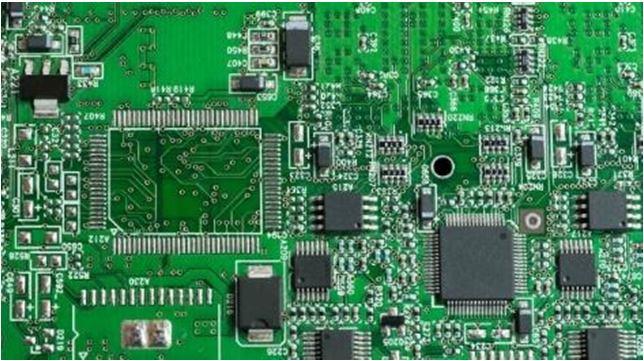
Refrigerator
Refrigerant, wires, tubes, liners
Adapted from: (He and Xu, 2014; Zhang & Xu, 2016)
ISSN: 2321-9653; IC Value: 45.98; SJ Impact Factor: 7.538

Volume 11 Issue I Jan 2023- Available at www.ijraset.com
Table 2.2. Useful and Hazardous Components in WEEE
Component Useful components
Hazardous materials
PCBs Resin, copper, glass, fibre Brominated flame retardant, heavy metals
CRT Glass Pb (PbO)
LCD Glass, In2O3 Liquid crystal, TAC, PVA
Wire Plastic, copper, aluminium Polychlorinated biphenyls
Adapted from: (He and Xu, 2014)
The United States Environmental Protection Agency (USEPA) stated that e-waste of 80 – 85 % by weight ends up in landfills and when they are leached the soil gets contaminated along with groundwater in adjacent regions. The study by Splavins et al., 2008 showed that when e-waste is mixed with municipal wastes the leaching of lead increased due to more aggressive acidic conditions. It has been reported by Vehlow et al., 2000 that the incineration of e-waste with municipal waste will lead to the formation of brominated and chlorinated dioxins and furans which are extremely toxic chemicals. Therefore, the use of open indiscriminate dumping, burning (Figure 2.2 a-b), landfill and incineration for the management of WEEE are not environmentally friendly options and don’t comply with the sustainability principles (Vehlow et al., 2000; Splavins et al., 2008; Adediran & Abdulkarim, 2012; Tuncuk et al., 2012; Hadi et al., 2015; Wang and Xu, 2015).
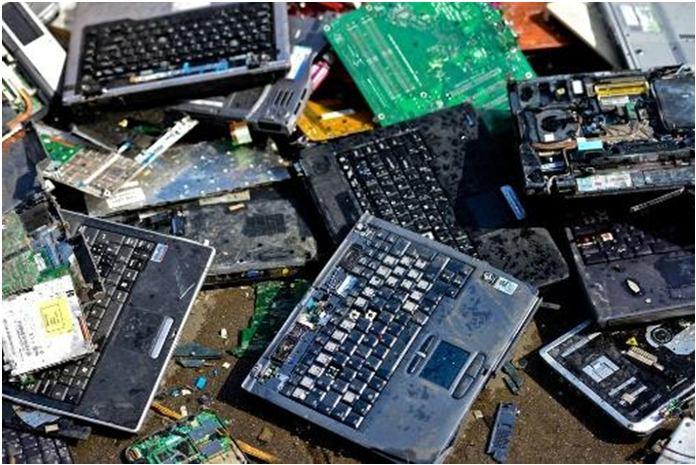
There is high value of precious metals in e-wastes and PCBs contains larger portions of precious metals since microelectronic components like capacitors and semiconductor chips are mounted on them. Most electric and electronic equipment contain PCBs which make up 3 % of all WEEE produced. Nearly 160 – 210 kg of copper and 80 – 1,500 g of gold can be contained in one metric ton of circuit boards and, when compared to mining in the United States, the amount of gold is 40 – 800 times and the amount copper is 30 – 40 times the amounts present in the ores which are currently being processed. PCBs are the most economically attractive portion of WEEE but as they are mixed with both hazardous and precious materials such as metals, organics, fibre glass, plastics in small volumes it poses difficulty in extraction, recovery and recycling of materials of interest. Table 2.3 shows the composition of materials in a populated PCB. The separation techniques also limit the exploitation of the materials that can be recovered and the pre-treatment of PCBs is important in the recycling process (Grossman, 2007; Adediran & Abdulkarim, 2012; Tuncuk et al., 2012; Canal et al., 2013; He & Xu 2014; Hadi et al., 2015; Wang & Xu, 2015; Akbari, 2019). When the value of resale for a metal can cover the cost of recovery it is given a high priority (Yordanov, 1998).
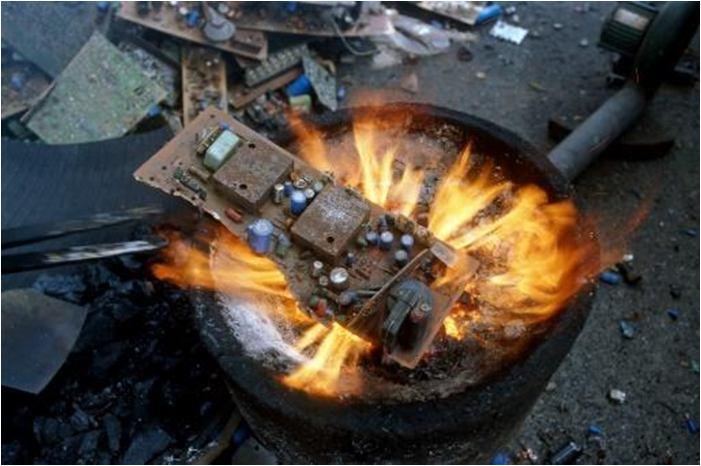
ISSN: 2321-9653; IC Value: 45.98; SJ Impact Factor: 7.538

Volume 11 Issue I Jan 2023- Available at www.ijraset.com
III. PRE-TREATMENT OF PCBS
In recycling WEEE, a pre-treatment step is carried out and this is a physical process of mechanically breaking and then crushing the PCBs. At first, the electronic components are dismantled and are further concentrated based on their physical properties. The physical properties mainly considered are metals and non-metals and this is achieved by using one of the following methods: magnetic separation, eddy current separation, screening, pneumatic separation and electrostatic separation. To completely separate magnetic fractions of the crushed PCBs it is best to use the magnetic separation. However, some non-ferrous metals might be included as a result of insufficient liberation. Eddy-current is more suitable for aluminium fractions and sieving crushed PCBs is necessary as this will help to prevent the influence of different particle sizes during separation. The hazardous components on PCBs are selectively disassembled as this would reduce the amount of toxic elements ending up in the mainstream of the recycling process. During the crushing of PCBs the local temperature of the PCBs increase and some researchers have argued that this process may result in agglomeration and localized pyrolysis of plastics. However, Yuan et al. 2007 researched on using low temperature for crushing PCBs but the method involved high energy cost (Zhang et al., 2012; Havlik et al., 2014; Ghosh et al., 2015; Silvas, 2015).
IV. HYDROMETALLURGY
Hydrometallurgy process uses a procedure known as leaching where a solution is used to solubilize the crushed metal waste. It also involves purification (solvent extraction or ion exchange) and metal recovery. Hydrometallurgy has one or more aqueous phase and it has been studied as an independent discipline from the alchemist’s days. Over the years researches have been conducted to determine hydrometallurgical processes with less setup costs which may be suitable for small scale with high metal yields. Hydrometallurgy is cheap since it requires less capital and high metal recovery but it is disadvantaged by the high level of toxic pollutants such as NOx, Cl2 & SO2. Hydrometallurgy is more suitable method of metal extraction as the primary ores needed for metal refining has become lower in grade (Conard, 1992; Salgado et al., 2003; Mooiman et al., 2005; Arens & Chernyak, 2008; Sepulveda, 2010; Jadhav & Hocheng, 2015; Jadhav et al., 2016). Hydrometallurgy involves the use of acid or base for leaching; it may be combined with electrowinning. Examples of these acidic and basic solvents used for hydrometallurgy are hydrochloric acid (HCl), nitric acid (HNO3), sulfuric acid (H2SO4), thiosulphate (S2O3 2-), thiourea ((NH2)2CS), sodium cyanide (NaCN). They are known to have several effects on health and environment because the acids solubilize metals and the use of sulfates to remove metals from its solid phase produces harmful sulfate-rich by-product. A large-scale release of this by-product could affect drainage systems. The use of H2SO4, HCl and HNO3 or aqua-regia have been investigated by several researchers as very effective leaching agent for heavy metals but the gases released through this process comprises Cl2, SO2 and NOx which poses threat to the persons involved in the experiment and the environment. Some other hydrometallurgical problems include solid-liquid separation difficulty and the impact of impurities during purification, time it takes to recover high amount of metals as the process is done in lower temperatures (Li et al., 2010, Park et al., 2013, Park et al., 2014). Some researchers have considered microwave-assisted leaching as a way of improving metal extraction yield and also reducing the process time. Connel & Moe 1966 were the earliest to research the use of microwave energy for heating minerals. Microwave technology is a type of electromagnetic energy which moves through high frequency waves. The microwave energy is a non-contact form of heating also known in the family of electro-heat techniques like infrared heating, radio frequency, direct resistance and induction. It is a very selective heating that is rapid with very efficient energy transfer. It initiates quickly and also terminates quickly. Microwave energy operates within a wavelength of 1 mm to 1 m and a frequency between 300 MHz to 300 GHz. The frequency used the most for the purpose of heating is 915 MHz to 2.45 GHz. In the dissolution stage, metals can be separated if one metal is insoluble in the solvent used. To remove components from the mixture selectively the leaching process usually follows the separation process (Connell & Moe, 1966; Fleming, 1992; Mooiman et al., 2005; Demim et al, 2013a; Demim et al, 2013b; Demim et al, 2014; Leyma et al, 2016; Yang et al., 2016).
A. Solvents for Leaching
Common solvents for recovery of metals as reported by other researchers are HNO3, HCl, H2SO4 and aqua-regia. Other solvents which are reported in the literature for the extraction of different metals consist of ionic liquids (ILs), cyanide (CN), thiosulfates, thiourea, and Ethylenediaminetetraacetic acid (EDTA). The rate of leaching can be affected by adjusting factors like temperature, stirring intensity, granularity, solid to solution ratio, acid-adding method and acid concentration. A typical leaching setup is shown in Figure 2.3. Recycling cost would benefit from reducing the sizes of the PCB as this was reported in the research by Dalrymple, 2007. (Dalrymple, 2007; Oishi et al 2007; Dhawan et al., 2009; Jadhav & Hocheng, 2015). Acid, base and salts may be combined in varying proportions to enhance the leaching efficiency of various types of leaching agents. Consequently, the addition of reducing
ISSN: 2321-9653; IC Value: 45.98; SJ Impact Factor: 7.538

Volume 11 Issue I Jan 2023- Available at www.ijraset.com agents such as SO2 & Fe2+ and oxidizing agents like HClO, H2O2, NaClO & Cl2 can also be used to enhance leaching process. One of the most widely used oxidizing agents is H2O2 because of its good properties; it is relatively versatile, powerful and safe. It is known to be stronger than potassium permanganate, chlorine and chlorine dioxide (Oh et al., 2003; Havlik et al, 2005; Oustadakis et al., 2010; Shawabkeh, 2010; Jadhav & Hocheng, 2015; Wu et al., 2015).
B. Traditional Solvents - Mineral Acids
Mineral acids are formed from inorganic compounds and when dissolved in water they form conjugate base and hydrogen ion. Dhawan et al., 2009’s report suggested that HNO3 is more effective than HCl and H2SO4 in leaching metals from PCB. Oishi et al 2007 reported that a leach liquor of 45 – 50 g/L was obtained when ammonium sulphate and chloride solutions with oxidizing agent (copper ammine complexes) were used to leach PCB. Almost 100 % of zinc and copper were dissolved when a combination of 2 mol/L H2SO4 and 0.2 mol/L H2O2 were used to leach PCB at 85 0C for 8 hours. Although Habbache et al, 2009 reported nitrate, chloride and sulfate ions as really aggressive for metal recovery but these inorganic acids are disadvantaged as they release toxic gases (NOx, Cl2 & SO2) and further purification steps are required. Metal recovery through this process is non-selective as the metals are extracted as mixed metal solutions and a further purification step is required to separate individual metals. When PCBs were shredded to less than 1mm, 95 % aluminium, iron and nickel were leached within 12 hours. Ground PCBs have also been researched by Veit et al., 2005, Wu et al., 2008. Other researchers have also combined complexants and oxidants to study the dissolution of copper (Oh et al, 2003; Du, 2004; Veit et al., 2005; Dalrymple, 2007; Oishi et al 2007; Wu et al., 2008; Dhawan et al., 2009; Kumar et al., 2014; Jadhav & Hocheng, 2015; Wang et al. 2016).
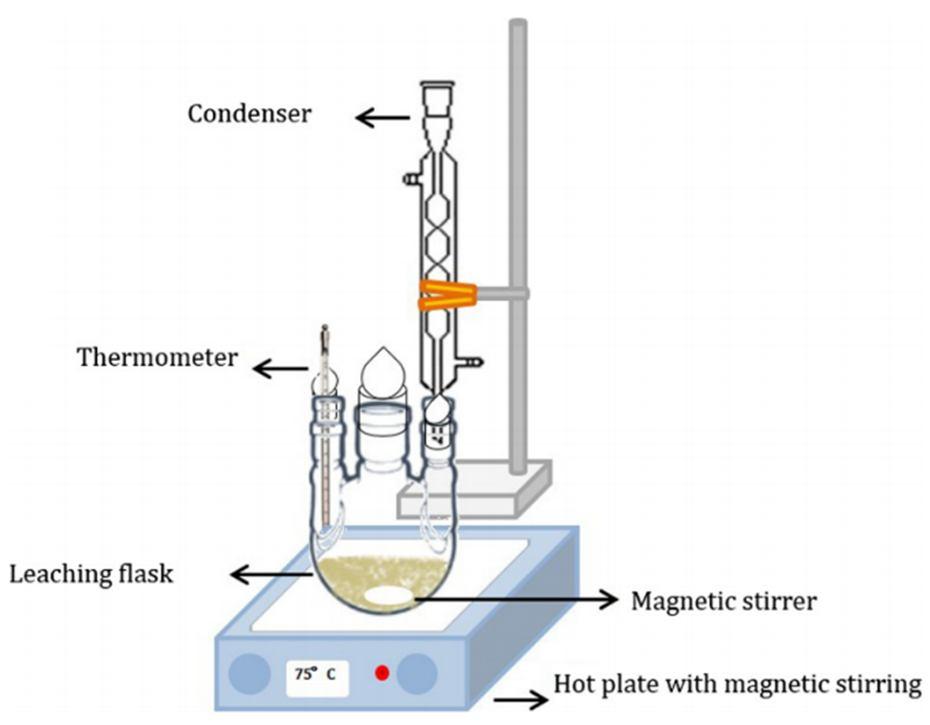
C. Traditional Solvents - Organic Acids
Organic acids are compounds composed mainly of carbon and hydrogen atoms. Examples of organic acids used for leaching are citric acid, malic, tartaric acid, and EDTA. Researchers have studied the dissolution behaviour of copper in citric acid using H2O2 as oxidizer. Also, glycine as complexing agent and H2O2 as oxidizing agent has been used for copper dissolution; copper dissolution was also studied using oxalic acid and H2O2 by Pandija et al. 2007. Organic acids are considered environmentally friendly and are attracting attention lately since they are biodegradable. The recovery of Pb and PbO from scrap battery paste has been studied by Sonmez & Kumar, 2009 using citric acid monohydrate; 4 M of citric acid monohydrate with H2O2 was sufficient to leach PbO2. Citric acid is a natural acid, biodegradable and can dissolve in water with ease; it degrades in both aerobic and anaerobic conditions as it has also been used for the recovery of metals from sewage sludge. Jadhav et al., 2016 research showed that citric acid and acetic acid were used to leach large PCB for 96 hours and 364 hours but poor metal slubilization was observed as only 9.89 % and 19.57 % of copper respectively was recovered. However, Li et al., 2010 research recovered 100 % Li and 90 % Co using 1.25 M citric acid and 1 % vol H2O2 at 90 0C for 30 min and a solid to liquid ratio of 20 g/L (Seal et al., 2003; Chen et al., 2004; Chen & Tsai, 2004; Du et al., 2004; Pandija et al. 2007; Sonmez & Kumar, 2009; Li et al., 2010; Jadhav & Hocheng, 2015; Wang et al. 2016).


